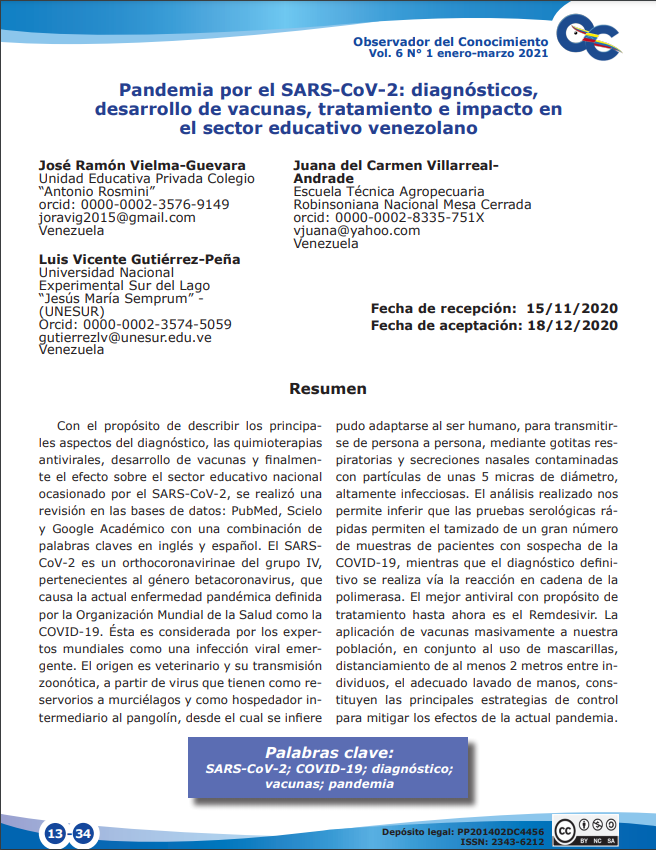Pandemia por el SARS-CoV-2: diagnósticos, desarrollo de vacunas, tratamiento e impacto en el sector educativo venezolano
Palabras clave:
SARS-CoV-2; COVID-19; diagnóstico; vacunas; pandemiaResumen
Con el propósito de describir los principales aspectos del diagnóstico, las quimioterapias antivirales, desarrollo de vacunas y finalmente el efecto sobre el sector educativo nacional ocasionado por el SARS-CoV-2, se realizó una revisión en las bases de datos: PubMed, Scielo y Google Académico con una combinación de palabras claves en inglés y español. El SARS-CoV-2 es un orthocoronavirinae del grupo IV, pertenecientes al género betacoronavirus, que causa la actual enfermedad pandémica definida por la Organización Mundial de la Salud como la COVID-19. Ésta es considerada por los expertos mundiales como una infección viral emergente. El origen es veterinario y su transmisión zoonótica, a partir de virus que tienen como reservorios a murciélagos y como hospedador intermediario al pangolín, desde el cual se infiere pudo adaptarse al ser humano, para transmitirse de persona a persona, mediante gotitas respiratorias y secreciones nasales contaminadas con partículas de unas 5 micras de diámetro, altamente infecciosas. El análisis realizado nos permite inferir que las pruebas serológicas rápidas permiten el tamizado de un gran número de muestras de pacientes con sospecha de la COVID-19, mientras que el diagnóstico definitivo se realiza vía la reacción en cadena de la polimerasa. El mejor antiviral con propósito de tratamiento hasta ahora es el Remdesivir. La aplicación de vacunas masivamente a nuestra población, en conjunto al uso de mascarillas, distanciamiento de al menos 2 metros entre individuos, el adecuado lavado de manos, constituyen las principales estrategias de control para mitigar los efectos de la actual pandemia.
Descargas
Citas
AHN, D. G., SHIN, H. J., KIM, M. H., LEE, S., KIM, H. S., MYOUNG, J., KIM, B. T., and KIM, S. J. (2020). Current Status of Epidemiology, Diagnosis, Therapeutics, and Vaccines for Novel Coronavirus Disease 2019 (COVID-19). Journal of Microbiology and Biotechnology, 30 (3), 313-324.
ARABI, Y., BALKHY, H., HAJEER, A. H., BOUCHAMA, A., HAYDEN, F. G., AL‐OMARI, A., AL-HAMEED, F. M., TAHA, Y., SHINDO, N., WHITEHEAD, J., MERSON, L., ALJOHANI, S., AL-KHAIRY, K., CARSON, G., LUKE, T. C., HENSLEY, L., AL-DAWOOD, A., AL-QAHTANI, S., MODJARRAD, K., SADAT, M., ROHDE, G., LEPORT, C. and FOWLER, R. (2015). Feasibility, safety, clinical, and laboratory effects of convalescent plasma therapy for patients with Middle East respiratory syndrome coronavirus infection: a study protocol. Springerplus, 4, 709.
BERRY, J. D., HAY, K., RINI, J.M., YU, M., WANG, L., PLUMMER, F. A., CORBETT, C. R. and ANDONOV, A. (2010). Neutralizing epitopes of the SARS-CoV S-protein cluster independent of repertoire, antigen structure or mAb technology. MAbs, 2 (1), 53-66.
CHEN, J. (2020). A pilot study of hydroxychloroquine in treatment of patients with common coronavirus disease-19 (COVID-19). Journal of Zhejiang University, doi: 10.3785/j.issn.1008-9292.2020.03.03.
CHEN, Y., CHAN, K. H., KANG, Y., CHEN, H., LUK, H. K., POON, R. W., CHAN, J. F. W., YUEN, K. Y., XIA, N., LAU, S. K. P. and WOO, P.C.Y. (2015). A sensitive and specific antigen detection assay for Middle East respiratory syndrome coronavirus. Emerging Microbes Infections, 4, e26.
Choy, K.T., WONG, A.Y.L., KAEWPREEDEE, P., SIA, S.F., CHEN, D., CHU, K.P.Y.H., D.K.W., CHAN, M.C.W., CHEUNG, P.P.H., HUANG, X., PEIRIS, M. and YENA, H.L. (2020). Remdesivir, lopinavir, emetine, and homoharringtonine inhibit SARS-CoV-2 replication in vitro. Antiviral Research, 178, 104786, doi: 10.1016/j.antiviral.2020.104786.
CHOY, M. (2016). Pharmaceutical approval update. P T. 41, 416-441.
Chu, C.M., CHENG, V.C., HUNG, I.F.N., WONG, M.M., CHAN, K.H., CHAN, K.S., KAO, R. Y. T., POON, L.L.M., WONG, C.L.P., GUAN, Y., PEIRIS, J.S.M., YUEN, K.Y. and HKU/UCH SARS Study Group. (2004). Role of lopinavir/ritonavir in the treatment of SARS: Initial virological and clover Biopharmaceuticals vaccines programs. Available from http://www.cloverbiopharma.com/index.php?m=content&c=index&a=lists&catid=42.
CORMAN, V. M., LANDT, O., KAISER, M., MOLENKAMP, R., MEIJER, A., CHU, D. K., BLEICKER, T., BRÜNINK, S., SCHNEIDER, J., SCHMIDT, M.L., MULDERS, D.G., HAAGMANS, B.L., VAN DER VEER, B., VAN DEN BRINK, S., WIJSMAN, L., GODERSKI, G., ROMETTE, J.L., ELLIS, J., ZAMBON, M., PEIRIS, M., GOOSSENS, H., REUSKEN, C., KOOPMANS, M.P. and DROSTEN, C. (2020). Detection of 2019 novel coronavirus (2019-nCoV) by real-time RT-PCR. Euro Surveillance, 25, 25(3), doi: 10.2807/1560-7917.
COUGHLIN, M. M. and PRABHAKAR, B. S. (2012). Neutralizing human monoclonal antibodies to Severe acute respiratory syndrome coronavirus: target, mechanism of action and therapeutic potential. Revista Médica de Virología, 22 (1), 2-17.Clinical findings. Thorax, 59, 252-256.
DAVEY, R. T., DODD, L., PROSCHAN, M. A., NEATON, J., NEUHAUS-NORDWALL, J., KOOPMEINERS, J.S., BEIGEL, J., TIERNEY, J., LANE, H.C., FAUCI, A.S., MASSAQUOI, M.B.S., SAHR, F. and MALVY, D. (2016). A randomized, controlled trial of ZMapp for Ebola Virus infection. New England of Journal Medicine, 375 (15), 1448-1456.
DE CLERCQ, E. (2019). New nucleoside analogues for the treatment of hemorrhagic fever virus infections. Chemical Asian Journal, 14, 3962-3968.
FIGUERA, M.; HERNÁNDEZ, M,; RÍOS, A.; VILLARROEL, H.; CASTRO, J.; CARBALLO, M.; LANDAETA, M.E.; GUZMÁN, M.; MAGO, H.; BACCI, S.; COMEGNA, M.; CARNEVALE, M.; LÓPEZ, M. G.; VALENZUELA, P.; DE ABREU, F. y CÁCERES, A.M. (2020). COVID-19: abordaje terapéutico y recomendaciones de la Sociedad Venezolana de Infectología. Boletín Venezolano de Infectología, 31 (1), 7-24.
GREENOUGH, T. C., BABCOCK, G. J., ROBERTS, A., HERNÁNDEZ, H. J., THOMAS, W. D., COCCIA, J. A., GRAZIANO, R.F., SRINIVASAN, M., LOWY, I., FINBERG, R. W., SUBBARAO, K., VOGEL, L., SOMASUNDARAN, M., LUZURIAGA, K., SULLIVAN, J.L. and AMBROSINO, D.M. (2005). Development and characterization of a Severe acute respiratory syndrome-associated coronavirus-neutralizing human monoclonal antibody that provides effective immunoprophylaxis in mice. Journal of Infectious Disease, 191 (4), 507-514.
GUPTA, P., KAMATH, A. V., PARK, S., CHIU, H., LUTMAN, J., MAIA, M., TAN, M.W., XU, M., SWEM, L. and DENG, R. (2016). Preclinical pharmacokinetics of MHAA4549A, a human monoclonal antibody to influenza A virus, and the prediction of its efficacious clinical dose for the treatment of patients hospitalized with influenza A. MAbs, 8 (5), 991-997.
HOLSHUE, M.L., DEBOLT, C., LINDQUIST, S., LOFY, K.H., WIESMAN, J., BRUCE, H., SPITTERS, C., ERICSON, K., WILKERSON, S., TURAL, A., DIAZ, G., COHN, A., FOX, L., PATEL, A., GERBER, S.I., KIM, L., TONG, S., LU, X., LINDSTROM, S., PALLANSCH, M.A., WELDON, W.C., BIGGS, H.M., UYEKI, T.M., PILLAI, S.K. and Washington State 2019-nCoV Case Investigation Team. (2020). First Case of 2019 Novel Coronavirus in the United States. New England of Journal Medicine, 382, 929-936.
LEYSSEN, P., BALZARINI, J., DE CLERCQ, E. and NEYTS, J. (2005). The predominant mechanism by which ribavirin exerts its antiviral activity in vitro against flaviviruses and paramyxoviruses is mediated by inhibition of IMP dehydrogenase. Journal of Virology, 79, 1943-1947.
LIM, J., JEON, S., SHIN, H.Y., KIM, M.J., SEONG, Y.M., LEE, W.J., CHOE, K.W., KANG, Y.M., LEE, B. and PARK, S.J. (2020). Case of the Index Patient Who Caused Tertiary Transmission of Coronavirus Disease 2019 in Korea: The Application of Lopinavir/Ritonavir for the Treatment of COVID-19 Pneumonia Monitored by Quantitative RT-PCR. Journal of Korean Medicine Science, 35 (6), e79.
LIU, Y., LI, J. and FENG, Y. (2020). Critical care response to a hospital outbreak of the 2019-nCoV infection in Shenzhen, China. Critical Care, 24, 56.
LU, R., ZHAO, X., LI, J., NIU, P., YANG, B., WU, H., WANG, W., SONG, H., HUANG, B., ZHU, N., BI, Y., MA, X., ZHAN, F., WANG, L., HU, T., ZHOU, H., HU, Z., ZHOU, W., ZHAO, L., CHEN, J., MENG, Y., WANG, J., LIN, Y., YUAN, J., XIE, Z., MA, J., LIU, W.J., WANG, D., XU, W., HOLMES, E.C., GAO, G.F., WU, G., CHEN, W., SHI, W. and TAN, W. (2020). Genomic characterisation and epidemiology of 2019 novel coronavirus: implications for virus origins and receptor binding. Lancet, 395, 565-574.
MADRID-RANGEL, B., GUTIÉRREZ, L.V. y VIELMA, J. R. (2020). La enseñanza de la química desde la perspectiva de una educación para el desarrollo sostenible. Acta Bioclínica, 10 (19), 6-43.
MAJUMDER, V., MUKERJEE, A., HAJRA, S. K., SAHA, B. AND SAHA, K. (1996). Immunotherapy of Far-Advanced Lepromatous Leprosy Patients with Low-Dose Convit Vaccine Along with Multidrug Therapy (Calcutta Trial). International Journal of Lepra and Other Mycobacterium Disease, 64 (1), 26-36.
MAIR-JENKINS, J., SAAVEDRA-CAMPOS, M., BAILLIE, J. K., CLEARY, P., KHAW, F. M., LIM, W.S., Makki, S., Rooney, K.D., Nguyen-Van-Tam, J.S. and Beck, C.R. (2015). The effectiveness of convalescent plasma and hyperimmune immunoglobulin for the treatment of severe acute respiratory infections of viral etiology: a systematic review and exploratory meta-analysis. Journal of Infectious Disease, 211 (1), 80-90.
MEYER, B., DROSTEN, C. and MULLER, M. A. (2014). Serological assays for emerging coronaviruses: challenges and pitfalls. Virus Research, 194, 175-183.
MUPAPA, K., MASSAMBA, M., KIBADI, K., KUVULA, K., BWAKA, A., KIPASA, M., COLEBUNDERS, R. and MUYEMBE-TAMFUM, J. J. (1999). Treatment of Ebola hemorrhagic fever with blood transfusions from convalescent patients. International Scientific and Technical Committee. Journal of Infectious Disease, 179, 18-23.
Publicity Department of the People’s Republic of China. (2020). Press conference of the joint prevention and control mechanism of state council on Feb 17, 2020. http://www.nhc.gov.cn/xcs/fkdt/202002/f12a62d10c2a48c6895cedf2faea6e1f.shtml
SHANMUGARAJ, B., SIRIWATTANANON, K., WANGKANONT, K., and PHOOLCHAROEN, W. (2020). Perspectives on monoclonal antibody therapy as potential therapeutic intervention for Coronavirus disease-19 (COVID-19). Asian Pacific Journal of Allergy and Immunology, 10-18.
SIMSEK YAVUZ, S. and ÜNAL, S. (2020). Antiviral treatment of COVID-19. Turkish Journal of Medical Sciences, 50, 611-619.
SPARROW, E., FRIEDE, M., SHEIKH, M. AND TORVALDSEN, S. (2017). Therapeutic antibodies for infectious diseases. Bulletin of World Health Organization, 95 (3), 235-237.
SUI, J., LI, W., MURAKAMI, A., TAMIN, A., MATTHEWS, L. J., WONG, S. K., MOORE M. J., TALLARICO A. S., MOBOLAJI, O., OLURINDE, M., CHOE, H., ANDERSON, L. J., BELLINI, W. J., FARZAN, M. and MARASCO, W. A. (2004). Potent neutralization of severe acute respiratory syndrome (SARS) coronavirus by a human mAb to S1 protein that blocks receptor association. Proceedings of the National Academy of Sciences, 101 (8), 2536-2541.
SUI, J., LI, W., ROBERTS, A., MATTHEWS, L. J., MURAKAMI, A., VOGEL, L., WONG, S. K., SUBBARAO, K., FARZAN, M. and MARASCO, W. A. (2005). Evaluation of human monoclonal antibody 80R for immunoprophylaxis of severe acute respiratory syndrome by an animal study, epitope mapping, and analysis of spike variants. Journal of Virology, 79 (10), 5900-5906.
VAN DOREMALEN, N., FALZARANO, D., YING, T., DE WIT, E., BUSHMAKER, T., FELDMANN, F., ATSUSHI OKUMURA, YANPING WANG, SCOTT D.P., HANLEY, P.W., FELDMANN, H., DIMITROV, D. S., VINCENT, D. AND MUNSTERA. J. (2017). Efficacy of antibody-based therapies against Middle East respiratory syndrome coronavirus (MERS-CoV) in common marmosets. Antiviral Research, 143, 30-37.
VIELMA, J. R. (2018 b) Armando Reverón, Margot Benacerraf y los procesos resilientes de los venezolanos. (Editorial). Acta Bioclínica, 8 (16), 1-11.
VIELMA, J., BUELVAS, N., SUÁREZ, R., GUTIÉRREZ, L., CHIRINOS, R., PÉREZ, I., VILLARREAL, J. y URDANETA, H. (2018). Esfuerzos para el desarrollo de vacunas y adyuvantes. Acta Bioclínica, 8 (15), 259-287.
VIELMA, J.R. (2018 A). Araya de Margot Benacerraf: A 59 años de la nominación a la Palma de Oro en Cannes. Un hito del cine venezolano que no debe quedar en el olvido… Editorial. Acta Bioclínica, 8 (15), 1-8.
VIELMA, J. R. y CONCEPCIÓN, J. L. (2005). Diagnóstico de la enfermedad de Chagas utilizando como antígeno la proteína recombinante de 24 kDa (Pgr24). [Trabajo especial de grado], Maestría en Biología Celular, Posgrado Interdisciplinario en Biología Celular, Facultad de Ciencias, Universidad de Los Andes, Mérida, 155 p.
VIELMA, J. R., URDANETA-ROMERO, H., VILLARREAL, J. C., PAZ, L. A., GUTIÉRREZ, L. V., MORA, M. and CHACÍN-BONILLA, L. (2014). Neurocysticercosis: Clinical Aspects, Immunopathology, Diagnosis, Treatment and Vaccine Development. Epidemiology Open Access, 4, 156. DOI: 10.4172/2161-1165.1000156.
VIELMA-GUEVARA, J. R.; VILLARREAL-ANDRADE, J. C.; GUTIÉRREZ-PENA, L.V. (2020). Pandemia por SARS-CoV-2: aspectos biológicos, epidemiológicos y clínicos. Observador del Conocimiento, 5 (3), 57-78.
WANG, C., HORBY, P. W., HAYDEN, F. G. and GAO, G. F. (2020 a). A novel coronavirus outbreak of global health concern. Lancet, 395, 470-473.
WANG, M., CAO, R., ZHANG, L., YANG, X., LIU, J., XU, M., SHI, Z., HU, Z., ZHONG, W. and XIAO, G. (2020 b). Remdesivir and chloroquine effectively inhibit the recently emerged novel coronavirus (2019-nCoV) in vitro. Cells Research, 30, 269-271.
World Health Organization. (2020). Laboratory testing of 2019 novel coronavirus (2019-nCoV) in suspected human cases: interim guidance, 17 January 2020. Interim Guidance. Available from: https://www.who.int/publications/i/item/laboratory-testing-of-2019-novel-coronavirus-(-2019-ncov)-in-suspected-human-cases-interim-guidance-17-january-2020
World Health Organization. (2021). COVID-19 Weekly Epidemiological Update. Data as received by WHO from national authorities, as of 21 March 2021, 10 am CET. 31 p. Available from: https://www.who.int/publications/m/item/weekly-epidemiological-update-on-covid-19-23-march-2021
ZHAI, P., DING, Y., WU, X., LONG, J., ZHONG, Y. AND LI, Y. (2020). The epidemiology, diagnosis and treatment of COVID-19. International Journal of Antimicrobial Agents, 55, 105955.
ZHANG, S., ZHOU, P., WANG, P., LI, Y., JIANG, L., JIA, W., WANG, H., FAN, A., WANG, D., SHI, X., FANG, X., HAMMEL, M., WANG, S., WANG, X. and ZHANG, L. (2018). Structural definition of a unique neutralization epitope on the Receptor-binding domain of MERS-CoV spike glycoprotein. Cell Report, 24 (2), 441-452.
ZHU, N., ZHANG, D., WANG, W., LI, X., YANG, B., SONG. J., ZHAO, X., HUANG, B., SHI, W., LU, R., NIU, P., ZHAN, F., MA, X., WANG, D., XU, W., WU, G., GAO, G.F., TAN, W. and China Novel Coronavirus Investigating and Research Team (2020). A novel coronavirus from patients with pneumonia in China, 2019. New England Journal Medicine, 382, 727–733.

Descargas
Publicado
Cómo citar
Número
Sección
Licencia

Esta obra está bajo una licencia internacional Creative Commons Atribución-SinDerivadas 4.0.







